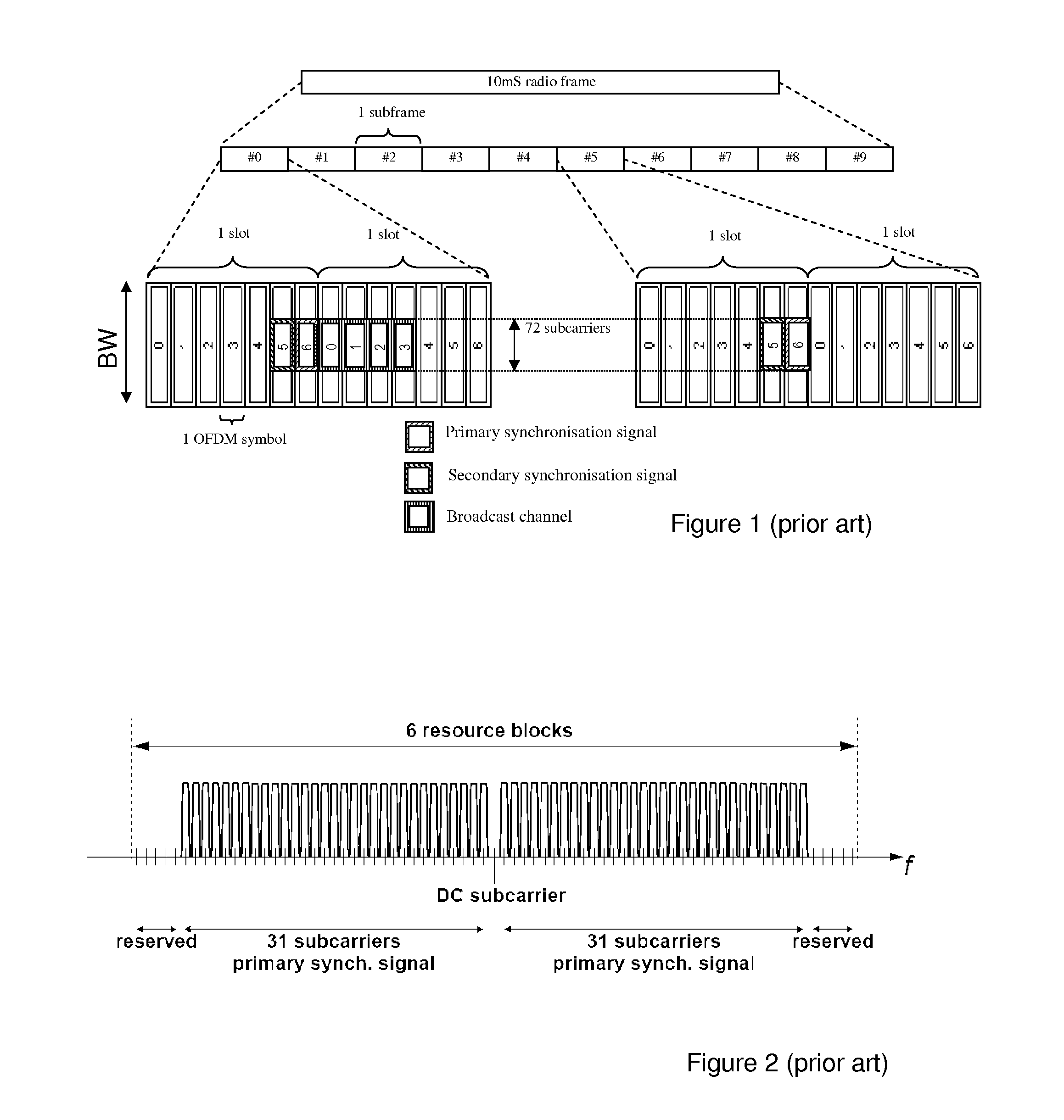Broadcast of Information for New Carrier Type
a new carrier type and broadcasting technology, applied in the field of broadcasting information, can solve the problems of not being able to use ue specific, unable to split and control channels, etc., and achieve the effect of improving the sinr for broadcasting information reception
- Summary
- Abstract
- Description
- Claims
- Application Information
AI Technical Summary
Benefits of technology
Problems solved by technology
Method used
Image
Examples
embodiment 1
[0049]In this embodiment, which relates to the EMIB detection, the EPBCH is transmitted within a subframe and within a bandwidth of L RBs (Resource Blocks), using the same structure as a distributed EPDCCH set with N≦L PRB pairs. If an NCT, like the LCT, supports the smallest LTE bandwidth of 6 RB, then L=6 also for higher system bandwidths, since the system bandwidth is unknown at the time of initially detecting the EPBCH.
[0050]Assuming L=6 in the following (although other values of L may be used if the NCT has a different solution than LCT, e.g., the smallest supported bandwidth is larger than L=6). Then inter-cell interference coordination is possible between two nodes that transmit EPBCH.
[0051]For example, N=2 can be used where the selection of which two PRB pairs out of the six possible are used depends on the Cell ID, for instance using a modulo-3 operation, see FIG. 5. FIG. 5 illustrates three EPBCH (Evolved Physical Broadcast Channel) configurations in a bandwidth of L=6 RB....
embodiment 2
[0061]This embodiment is a variant on embodiment 1, where all L=6 RB (other values of L are, however, not precluded) are allocated to EPBCH and the distributed EPDCCH structure is used. The L=6 PRB pairs contain 24 ECCEs (Enhanced Control Channel Elements) in normal cyclic prefix case but also other combinations of the EREGs (Enhanced Resource Element Groups) are possible to arrive at a fewer or more than 24 ECCEs. An example is 12 ECCEs. The Cell ID can then be used to indicate which subset of these 24 ECCEs that contains the EPBCH. Hence, in this embodiment, an EPBCH is mapped to all L PRB pairs.
[0062]For example, there may be 3 EPBCH candidates of size 8 ECCEs each. The Cell ID modulo-3 indicates which of these 3 non-overlapping sets of ECCEs that contains the EPBCH for the cell. An adjacent cell (base station) can then be configured with a different Cell ID, selected such that non-overlapping ECCEs will be used for the EPBCH in the adjacent cells when using e.g. a modulo-3 opera...
embodiment 3
[0069]In this exemplifying embodiment, the structure of a distributed EPDCCH set may be reused for the purpose of EPBCH transmission, but the EPBCH is transmitted in a different subframe than the PSS and / or SSS and / or ESS. This has the advantage that more REs are available in the EPBCH for RE mapping procedure, and the coverage is thus improved. It also has an advantage that potential collisions with DMRS for EPBCH and PSS or SSS are avoided.
[0070]The subframe where EPBCH is located can either be fixed relative the PSS and / or SSS subframe or it can be indicated e.g. by the Cell ID. Different Cell ID could therefore generate different locations for the EPBCH of this cell. For example a Cell ID modulo-3 operation could be used to indicate an offset of 1, 2 or 3 subframes with respect to the subframe where the UE finds the PSS or SSS.
[0071]As in embodiment 1, e.g. the Cell ID can additionally be used to indicate a subset of N RBs out of the L RBs where the EPBCH is located, see FIG. 9....
PUM
 Login to View More
Login to View More Abstract
Description
Claims
Application Information
 Login to View More
Login to View More - R&D
- Intellectual Property
- Life Sciences
- Materials
- Tech Scout
- Unparalleled Data Quality
- Higher Quality Content
- 60% Fewer Hallucinations
Browse by: Latest US Patents, China's latest patents, Technical Efficacy Thesaurus, Application Domain, Technology Topic, Popular Technical Reports.
© 2025 PatSnap. All rights reserved.Legal|Privacy policy|Modern Slavery Act Transparency Statement|Sitemap|About US| Contact US: help@patsnap.com



